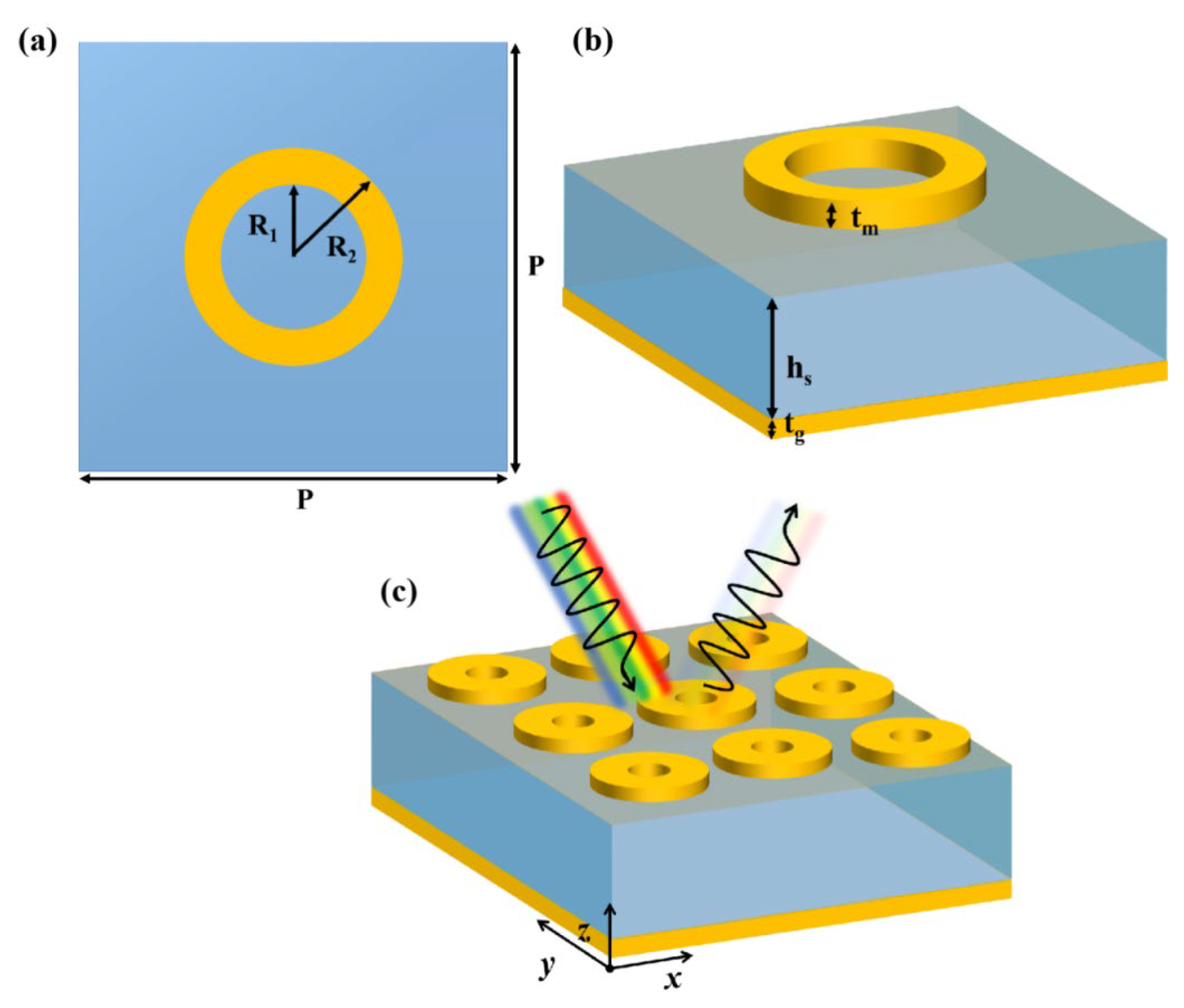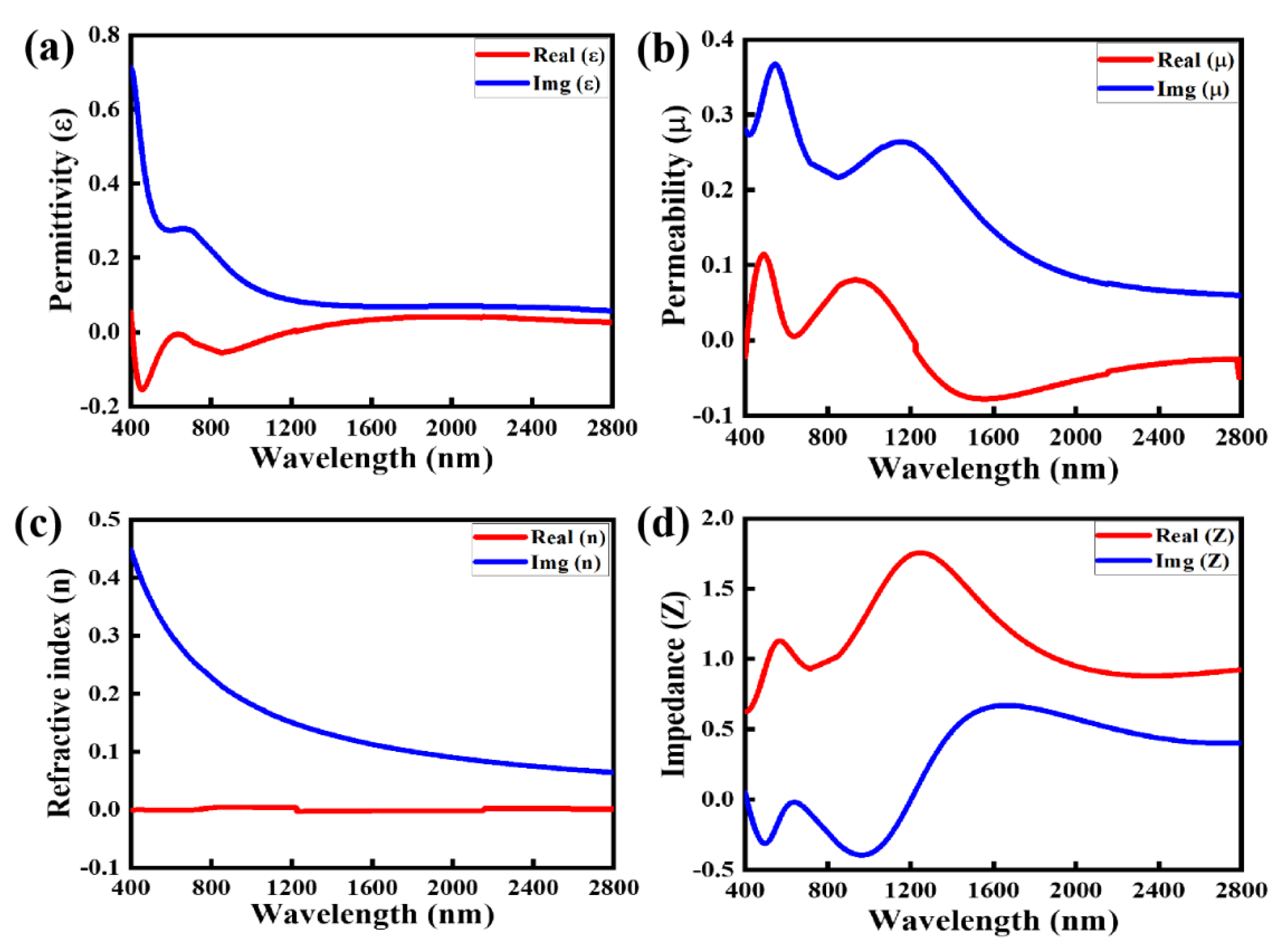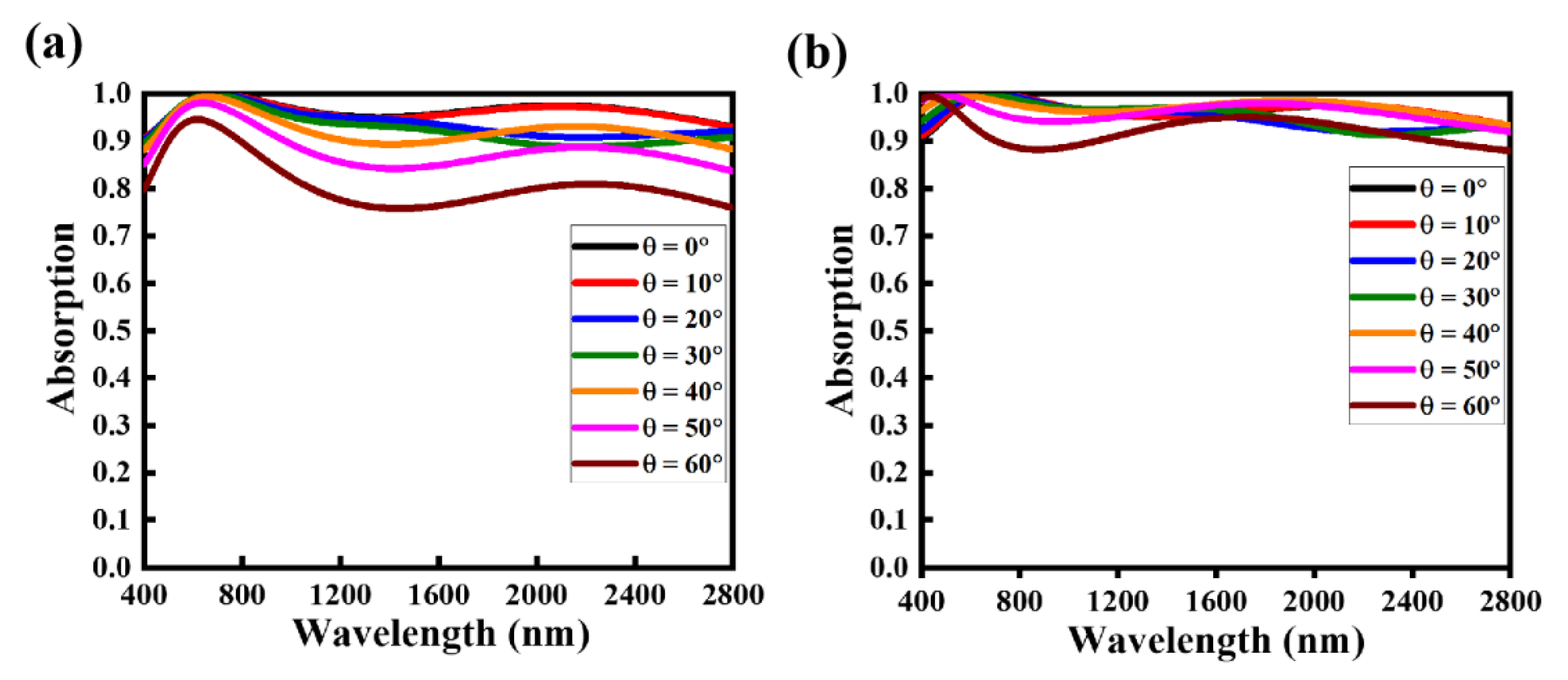Nickel-Based High-Bandwidth Nanostructured Metamaterial Absorber for Visible and Infrared Spectrum
Abstract
:1. Introduction
2. Design Architecture and Simulation of Unit Cell
3. Results and Discussion
4. Conclusions
Author Contributions
Funding
Data Availability Statement
Conflicts of Interest
References
- Grady, N.K.; Heyes, J.E.; Chowdhury, D.R.; Zeng, Y.; Reiten, M.T.; Azad, A.K.; Taylor, A.J.; Dalvit, D.A.; Chen, H.-T. Terahertz metamaterials for linear polarization conversion and anomalous refraction. Science 2013, 340, 1304–1307. [Google Scholar] [CrossRef] [PubMed]
- Valentine, J.; Li, J.; Zentgraf, T.; Bartal, G.; Zhang, X. An optical cloak made of dielectrics. Nat. Mater. 2009, 8, 568–571. [Google Scholar] [CrossRef] [PubMed]
- Javed, I.; Kim, J.; Naveed, M.A.; Oh, D.K.; Jeon, D.; Kim, I.; Zubair, M.; Massoud, Y.; Mehmood, M.Q.; Rho, J. Broad-Band Polarization-Insensitive Metasurface Holography with a Single-Phase Map. ACS Appl. Mater. Interfaces 2022, 14, 36019–36026. [Google Scholar] [CrossRef]
- Naveed, M.A.; Ansari, M.A.; Kim, I.; Badloe, T.; Kim, J.; Oh, D.K.; Riaz, K.; Tauqeer, T.; Younis, U.; Saleem, M. Optical spin-symmetry breaking for high-efficiency directional helicity-multiplexed metaholograms. Microsyst. Nanoeng. 2021, 7, 5. [Google Scholar] [CrossRef] [PubMed]
- Ahmad, T.; Rahim, A.A.; Bilal, R.M.H.; Noor, A.; Maab, H.; Naveed, M.A.; Madni, A.; Ali, M.M.; Saeed, M.A. Ultrawideband Cross-Polarization Converter Using Anisotropic Reflective Metasurface. Electronics 2022, 11, 487. [Google Scholar] [CrossRef]
- Huang, H.; Xia, H.; Xie, W.; Guo, Z.; Li, H.; Xie, D. Design of broadband graphene-metamaterial absorbers for permittivity sensing at mid-infrared regions. Sci. Rep. 2018, 8, 4183. [Google Scholar] [CrossRef]
- Huang, C.; Zappone, A.; Alexandropoulos, G.C.; Debbah, M.; Yuen, C. Reconfigurable intelligent surfaces for energy efficiency in wireless communication. IEEE Trans. Wirel. Commun. 2019, 18, 4157–4170. [Google Scholar] [CrossRef]
- Alam, M.; Massoud, Y. RLC ladder model for scattering in single metallic nanoparticles. IEEE Trans. Nanotechnol. 2006, 5, 491–498. [Google Scholar] [CrossRef]
- Hosseini, A.; Massoud, Y. Nanoscale surface plasmon based resonator using rectangular geometry. Appl. Phys. Lett. 2007, 90, 181102. [Google Scholar] [CrossRef]
- Hosseini, A.; Nejati, H.; Massoud, Y. Modeling and design methodology for metal-insulator-metal plasmonic Bragg reflectors. Opt. Express 2008, 16, 1475–1480. [Google Scholar] [CrossRef] [PubMed]
- Khan, M.A.; Mehmood, M.Q.; Massoud, Y. High-Temperature Annealing Effects on Atomically Thin Tungsten Diselenide Field-Effect Transistor. Appl. Sci. 2022, 12, 8119. [Google Scholar] [CrossRef]
- Khaliq, H.S.; Kim, J.; Naeem, T.; Riaz, K.; Badloe, T.; Seong, J.; Akbar, J.; Zubair, M.; Mehmood, M.Q.; Massoud, Y. Broadband Chiro-Optical Effects for Futuristic Meta-Holographic Displays. Adv. Opt. Mater. 2022, 2201175. [Google Scholar] [CrossRef]
- Smith, D.R.; Padilla, W.J.; Vier, D.; Nemat-Nasser, S.C.; Schultz, S. Composite medium with simultaneously negative permeability and permittivity. Phys. Rev. Lett. 2000, 84, 4184. [Google Scholar] [CrossRef] [PubMed]
- Massoud, Y.; Nieuwoudt, A. Modeling and design challenges and solutions for carbon nanotube-based interconnect in future high performance integrated circuits. ACM J. Emerg. Technol. Comput. Syst. (JETC) 2006, 2, 155–196. [Google Scholar] [CrossRef]
- Lee, D.; So, S.; Hu, G.; Kim, M.; Badloe, T.; Cho, H.; Kim, J.; Kim, H.; Qiu, C.-W.; Rho, J. Hyperbolic metamaterials: Fusing artificial structures to natural 2D materials. eLight 2022, 2, 1–23. [Google Scholar] [CrossRef]
- Wang, M.; Hu, G.; Chand, S.; Cotrufo, M.; Abate, Y.; Watanabe, K.; Taniguchi, T.; Grosso, G.; Qiu, C.-W.; Alù, A. Spin-orbit-locked hyperbolic polariton vortices carrying reconfigurable topological charges. eLight 2022, 2, 12. [Google Scholar] [CrossRef]
- Rodrigues, S.P.; Lan, S.; Kang, L.; Cui, Y.; Cai, W. Nonlinear imaging and spectroscopy of chiral metamaterials. Adv. Mater. 2014, 26, 6157–6162. [Google Scholar] [CrossRef]
- Mehmood, M.; Mei, S.; Hussain, S.; Huang, K.; Siew, S.; Zhang, L.; Zhang, T.; Ling, X.; Liu, H.; Teng, J. Visible-frequency metasurface for structuring and spatially multiplexing optical vortices. Adv. Mater. 2016, 28, 2533–2539. [Google Scholar] [CrossRef]
- Bilal, R.; Baqir, M.; Iftikhar, A.; Naqvi, S.; Mughal, M.; Ali, M. Polarization-controllable and angle-insensitive multiband Yagi-Uda-shaped metamaterial absorber in the microwave regime. Opt. Mater. Express 2022, 12, 798–810. [Google Scholar] [CrossRef]
- Mehrabi, S.; Bilal, R.M.H.; Naveed, M.A.; Ali, M.M. Ultra-broadband nanostructured metamaterial absorber based on stacked square-layers of TiN/TiO2. Opt. Mater. Express 2022, 12, 2199–2211. [Google Scholar] [CrossRef]
- Naveed, M.A.; Bilal, R.M.H.; Baqir, M.A.; Bashir, M.M.; Ali, M.M.; Rahim, A.A. Ultrawideband fractal metamaterial absorber made of nickel operating in the UV to IR spectrum. Opt. Express 2021, 29, 42911–42923. [Google Scholar] [CrossRef]
- Hu, Y.; Luo, X.; Chen, Y.; Liu, Q.; Li, X.; Wang, Y.; Liu, N.; Duan, H. 3D-Integrated metasurfaces for full-colour holography. Light Sci. Appl. 2019, 8, 86. [Google Scholar] [CrossRef] [PubMed]
- Wang, H.; Sivan, V.P.; Mitchell, A.; Rosengarten, G.; Phelan, P.; Wang, L. Highly efficient selective metamaterial absorber for high-temperature solar thermal energy harvesting. Sol. Energy Mater. Sol. Cells 2015, 137, 235–242. [Google Scholar] [CrossRef]
- Hosseini, A.; Massoud, Y. Optical range microcavities and filters using multiple dielectric layers in metal-insulator-metal structures. JOSA A 2007, 24, 221–224. [Google Scholar] [CrossRef] [PubMed]
- Hosseini, A.; Nejati, H.; Massoud, Y. Design of a maximally flat optical low pass filter using plasmonic nanostrip waveguides. Opt. Express 2007, 15, 15280–15286. [Google Scholar] [CrossRef]
- Abbas, M.A.; Kim, J.; Rana, A.S.; Kim, I.; Rehman, B.; Ahmad, Z.; Massoud, Y.; Seong, J.; Badloe, T.; Park, K. Nanostructured chromium-based broadband absorbers and emitters to realize thermally stable solar thermophotovoltaic systems. Nanoscale 2022, 14, 6425–6436. [Google Scholar] [CrossRef]
- Ijaz, S.; Rana, A.S.; Ahmad, Z.; Zubair, M.; Massoud, Y.; Mehmood, M.Q. The Dawn of Metadevices: From Contemporary Designs to Exotic Applications. Adv. Devices Instrum. 2022, 2022, 9861078. [Google Scholar] [CrossRef]
- Ma, Q.; Gao, W.; Xiao, Q.; Ding, L.; Gao, T.; Zhou, Y.; Gao, X.; Yan, T.; Liu, C.; Gu, Z. Directly wireless communication of human minds via non-invasive brain-computer-metasurface platform. elight 2022, 2, 11. [Google Scholar] [CrossRef]
- Landy, N.I.; Sajuyigbe, S.; Mock, J.J.; Smith, D.R.; Padilla, W.J. Perfect metamaterial absorber. Phys. Rev. Lett. 2008, 100, 207402. [Google Scholar] [CrossRef]
- Ding, F.; Cui, Y.; Ge, X.; Jin, Y.; He, S. Ultra-broadband microwave metamaterial absorber. Appl. Phys. Lett. 2012, 100, 103506. [Google Scholar] [CrossRef] [Green Version]
- Bilal, R.; Naveed, M.; Baqir, M.; Ali, M.; Rahim, A. Design of a wideband terahertz metamaterial absorber based on Pythagorean-tree fractal geometry. Opt. Mater. Express 2020, 10, 3007–3020. [Google Scholar] [CrossRef]
- Naveed, M.A.; Bilal, R.M.H.; Rahim, A.A.; Baqir, M.A.; Ali, M.M. Polarization-insensitive dual-wideband fractal meta-absorber for terahertz applications. Appl. Opt. 2021, 60, 9160–9166. [Google Scholar] [CrossRef]
- Bilal, R.; Saeed, M.; Choudhury, P.; Baqir, M.; Kamal, W.; Ali, M.; Rahim, A. Elliptical metallic rings-shaped fractal metamaterial absorber in the visible regime. Sci. Rep. 2020, 10, 14035. [Google Scholar] [CrossRef] [PubMed]
- Hosseini, A.; Nieuwoudt, A.; Massoud, Y. Optimizing dielectric strips over a metallic substrate for subwavelength light confinement. IEEE Photonics Technol. Lett. 2007, 19, 522–524. [Google Scholar] [CrossRef]
- Hosseini, A.; Nieuwoudt, A.; Massoud, Y. Efficient simulation of subwavelength plasmonic waveguides using implicitly restarted Arnoldi. Optics Express 2006, 14, 7291–7298. [Google Scholar] [CrossRef] [PubMed]
- Li, L.; Zhao, H.; Liu, C.; Li, L.; Cui, T.J. Intelligent metasurfaces: Control, communication and computing. eLight 2022, 2, 7. [Google Scholar] [CrossRef]
- Nieuwoudt, A.; Massoud, Y. Understanding the impact of inductance in carbon nanotube bundles for VLSI interconnect using scalable modeling techniques. IEEE Trans. Nanotechnol. 2006, 5, 758–765. [Google Scholar] [CrossRef]
- Deng, G.; Chen, P.; Yang, J.; Yin, Z.; Qiu, L. Graphene-based tunable polarization sensitive terahertz metamaterial absorber. Opt. Commun. 2016, 380, 101–107. [Google Scholar] [CrossRef]
- Shen, H.; Liu, F.; Liu, C.; Zeng, D.; Guo, B.; Wei, Z.; Wang, F.; Tan, C.; Huang, X.; Meng, H. A polarization-insensitive and wide-angle terahertz absorber with ring-porous patterned graphene metasurface. Nanomaterials 2020, 10, 1410. [Google Scholar] [CrossRef] [PubMed]
- Alam, M.; Massoud, Y. A closed-form analytical model for single nanoshells. IEEE Trans. Nanotechnol. 2006, 5, 265–272. [Google Scholar] [CrossRef]
- Lim, S.; Mar, W.; Matheu, P.; Derkacs, D.; Yu, E. Photocurrent spectroscopy of optical absorption enhancement in silicon photodiodes via scattering from surface plasmon polaritons in gold nanoparticles. J. Appl. Phys. 2007, 101, 104309. [Google Scholar] [CrossRef]
- Yan, Z.; Tang, C.; Wu, G.; Tang, Y.; Gu, P.; Chen, J.; Liu, Z.; Huang, Z. Perfect absorption and refractive-index sensing by metasurfaces composed of cross-shaped hole arrays in metal substrate. Nanomaterials 2020, 11, 63. [Google Scholar] [CrossRef] [PubMed]
- Zhang, Y.; Lin, P.; Lin, Y.-S. Tunable split-disk metamaterial absorber for sensing application. Nanomaterials 2021, 11, 598. [Google Scholar] [CrossRef] [PubMed]
- Grant, J.; McCrindle, I.J.; Cumming, D.R. Multi-spectral materials: Hybridisation of optical plasmonic filters, a mid infrared metamaterial absorber and a terahertz metamaterial absorber. Opt. Express 2016, 24, 3451–3463. [Google Scholar] [CrossRef] [PubMed]
- Jin, Z.; Janoschka, D.; Deng, J.; Ge, L.; Dreher, P.; Frank, B.; Hu, G.; Ni, J.; Yang, Y.; Li, J. Phyllotaxis-inspired nanosieves with multiplexed orbital angular momentum. eLight 2021, 1, 5. [Google Scholar] [CrossRef]
- Iwaszczuk, K.; Strikwerda, A.C.; Fan, K.; Zhang, X.; Averitt, R.D.; Jepsen, P.U. Flexible metamaterial absorbers for stealth applications at terahertz frequencies. Opt. Express 2012, 20, 635–643. [Google Scholar] [CrossRef] [PubMed]
- Mason, J.; Smith, S.; Wasserman, D. Strong absorption and selective thermal emission from a midinfrared metamaterial. Appl. Phys. Lett. 2011, 98, 241105. [Google Scholar] [CrossRef]
- Bilal, R.; Baqir, M.; Choudhury, P.; Naveed, M.; Ali, M.; Rahim, A. Ultrathin broadband metasurface-based absorber comprised of tungsten nanowires. Results Phys. 2020, 19, 103471. [Google Scholar] [CrossRef]
- Kenney, M.; Grant, J.; Shah, Y.D.; Escorcia-Carranza, I.; Humphreys, M.; Cumming, D.R. Octave-spanning broadband absorption of terahertz light using metasurface fractal-cross absorbers. Acs Photonics 2017, 4, 2604–2612. [Google Scholar] [CrossRef]
- Qi, B.; Zhao, Y.; Niu, T.; Mei, Z. Ultra-broadband metamaterial absorber based on all-metal nanostructures. J. Phys. D Appl. Phys. 2019, 52, 425304. [Google Scholar] [CrossRef]
- Xie, Q.; Dong, G.; Wang, B.-X.; Huang, W.-Q. Design of quad-band terahertz metamaterial absorber using a perforated rectangular resonator for sensing applications. Nanoscale Res. Lett. 2018, 13, 137. [Google Scholar] [CrossRef] [PubMed]
- Zhou, Y.; Luo, M.; Shen, S.; Zhang, H.; Pu, D.; Chen, L. Cost-effective near-perfect absorber at visible frequency based on homogenous meta-surface nickel with two-dimension cylinder array. Opt. Express 2018, 26, 27482–27491. [Google Scholar] [CrossRef] [PubMed]
- Hoa, N.T.Q.; Lam, P.H.; Tung, P.D.; Tuan, T.S.; Nguyen, H. Numerical study of a wide-angle and polarization-insensitive ultrabroadband metamaterial absorber in visible and near-infrared region. IEEE Photonics J. 2019, 11, 1–8. [Google Scholar] [CrossRef]
- Bilal, R.M.H.; Baqir, M.A.; Hameed, M.; Naqvi, S.A.; Ali, M.M. Triangular metallic ring-shaped broadband polarization-insensitive and wide-angle metamaterial absorber for visible regime. JOSA A 2022, 39, 136–142. [Google Scholar] [CrossRef] [PubMed]
- Huo, D.; Zhang, J.; Wang, Y.; Wang, C.; Su, H.; Zhao, H. Broadband perfect absorber based on TiN-nanocone metasurface. Nanomaterials 2018, 8, 485. [Google Scholar] [CrossRef]
- Naik, G.V.; Kim, J.; Boltasseva, A. Oxides and nitrides as alternative plasmonic materials in the optical range. Opt. Mater. Express 2011, 1, 1090–1099. [Google Scholar] [CrossRef]
- Bilal, R.M.H.; Baqir, M.A.; Choudhury, P.K.; Karaaslan, M.; Ali, M.M.; Altłntas, O.; Rahim, A.A.; Unal, E.; Sabah, C. Wideband microwave absorber comprising metallic split-ring resonators surrounded with E-shaped fractal metamaterial. IEEE Access 2021, 9, 5670–5677. [Google Scholar] [CrossRef]
- Kim, I.; So, S.; Rana, A.S.; Mehmood, M.Q.; Rho, J. Thermally robust ring-shaped chromium perfect absorber of visible light. Nanophotonics 2018, 7, 1827–1833. [Google Scholar] [CrossRef]
- Liu, J.; Zhu, M.; Zhang, N.; Zhang, H.; Zhou, Y.; Sun, S.; Yi, N.; Gao, S.; Song, Q.; Xiao, S. Wafer-scale metamaterials for polarization-insensitive and dual-band perfect absorption. Nanoscale 2015, 7, 18914–18917. [Google Scholar] [CrossRef] [PubMed]
- Hu, C.; Li, X.; Feng, Q.; Chen, X.N.; Luo, X. Investigation on the role of the dielectric loss in metamaterial absorber. Opt. Express 2010, 18, 6598–6603. [Google Scholar] [CrossRef] [PubMed]
- Chen, X.; Grzegorczyk, T.M.; Wu, B.-I.; Pacheco Jr, J.; Kong, J.A. Robust method to retrieve the constitutive effective parameters of metamaterials. Phys. Rev. E 2004, 70, 016608. [Google Scholar] [CrossRef]
- Smith, D.; Schultz, S.; Markoš, P.; Soukoulis, C. Determination of effective permittivity and permeability of metamaterials from reflection and transmission coefficients. Phys. Rev. B 2002, 65, 195104. [Google Scholar] [CrossRef]
- Naveed, M.A.; Kim, J.; Ansari, M.A.; Kim, I.; Massoud, Y.; Kim, J.; Oh, D.K.; Badloe, T.; Lee, J.; Kim, Y. Single-Step Fabricable Flexible Metadisplays for Sensitive Chemical/Biomedical Packaging Security and Beyond. ACS Appl. Mater. Interfaces 2022, 14, 31194–31202. [Google Scholar] [CrossRef]
- Bilal, R.; Baqir, M.; Choudhury, P.K.; Ali, M.M.; Rahim, A.A.; Kamal, W. Polarization-insensitive multi-band metamaterial absorber operating in the 5G spectrum. Optik 2020, 216, 164958. [Google Scholar] [CrossRef]
- Naveed, M.A.; Kim, J.; Javed, I.; Ansari, M.A.; Seong, J.; Massoud, Y.; Badloe, T.; Kim, I.; Riaz, K.; Zubair, M. Novel Spin-Decoupling Strategy in Liquid Crystal-Integrated Metasurfaces for Interactive Metadisplays. Adv. Opt. Mater. 2022, 2200196. [Google Scholar] [CrossRef]
- Qian, Q.; Yan, Y.; Wang, C. Flexible metasurface black nickel with stepped nanopillars. Opt. Lett. 2018, 43, 1231–1234. [Google Scholar] [CrossRef] [PubMed]
- Liu, J.; Ma, W.-Z.; Chen, W.; Yu, G.-X.; Chen, Y.-S.; Deng, X.-C.; Yang, C.-F. Numerical analysis of an ultra-wideband metamaterial absorber with high absorptivity from visible light to near-infrared. Opt. Express 2020, 28, 23748–23760. [Google Scholar] [CrossRef] [PubMed]
- Liu, Z.; Liu, G.; Huang, Z.; Liu, X.; Fu, G. Ultra-broadband perfect solar absorber by an ultra-thin refractory titanium nitride meta-surface. Sol. Energy Mater. Sol. Cells 2018, 179, 346–352. [Google Scholar] [CrossRef]
- Hakim, M.L.; Hanif, A.; Alam, T.; Islam, M.T.; Arshad, H.; Soliman, M.S.; Albadran, S.M.; Islam, M. Ultrawideband Polarization-Independent Nanoarchitectonics: A Perfect Metamaterial Absorber for Visible and Infrared Optical Window Applications. Nanomaterials 2022, 12, 2849. [Google Scholar] [CrossRef] [PubMed]







| Design Configuration | Material | Device Layers | Optical Bandwidth (A ≥ 90%) | Angular Robustness | Polarization Insensitivity |
|---|---|---|---|---|---|
| Stacked-layers [20] | TiN, TiO2 | Multiple | 200–2800 nm | θ = 60° | Yes |
| Multiple-hexagons (Fractal) [21] | SiO2, Ni | Single | 820–2700 nm | θ = 60° | No |
| Nano-ellipses (Fractal) [33] | SiO2, W | Single | 400–750 nm | θ = 60° | No |
| Nano-cylinders [52] | Ni | Single | 400–650 nm | θ = 60° | Yes |
| Frustum-like nano-cones [53] | Si, Au | Multiple | 480–1480 nm | θ = 60° | Yes |
| Nano-triangular rings [54] | SiO2, Cr | Single | 400–750 nm | θ = 60° | Yes |
| Nano-pillars [66] | Ni | Single | 400–760 nm | θ = 70° | Yes |
| Nano-cubes [67] | SiO2, Ti, MgF2, Al | Multiple | 400–1500 nm | θ = 60° | Yes |
| Nano-disks [68] | SiO2, TiN, TiO2 | Multiple | 316–1426 nm | θ = 50° | Yes |
| Nano-hexagonal rings [69] | AlN, Ni | Single | 380–2500 nm | θ = 60° | Yes |
| Nano-circular ring (This study) | SiO2, Ni | Single | 400–2800 nm | θ = 60° | Yes |
Publisher’s Note: MDPI stays neutral with regard to jurisdictional claims in published maps and institutional affiliations. |
© 2022 by the authors. Licensee MDPI, Basel, Switzerland. This article is an open access article distributed under the terms and conditions of the Creative Commons Attribution (CC BY) license (https://creativecommons.org/licenses/by/4.0/).
Share and Cite
Bilal, R.M.H.; Saeed, M.A.; Naveed, M.A.; Zubair, M.; Mehmood, M.Q.; Massoud, Y. Nickel-Based High-Bandwidth Nanostructured Metamaterial Absorber for Visible and Infrared Spectrum. Nanomaterials 2022, 12, 3356. https://doi.org/10.3390/nano12193356
Bilal RMH, Saeed MA, Naveed MA, Zubair M, Mehmood MQ, Massoud Y. Nickel-Based High-Bandwidth Nanostructured Metamaterial Absorber for Visible and Infrared Spectrum. Nanomaterials. 2022; 12(19):3356. https://doi.org/10.3390/nano12193356
Chicago/Turabian StyleBilal, Rana Muhammad Hasan, Muhammad Ahsan Saeed, Muhammad Ashar Naveed, Muhammad Zubair, Muhammad Qasim Mehmood, and Yehia Massoud. 2022. "Nickel-Based High-Bandwidth Nanostructured Metamaterial Absorber for Visible and Infrared Spectrum" Nanomaterials 12, no. 19: 3356. https://doi.org/10.3390/nano12193356






